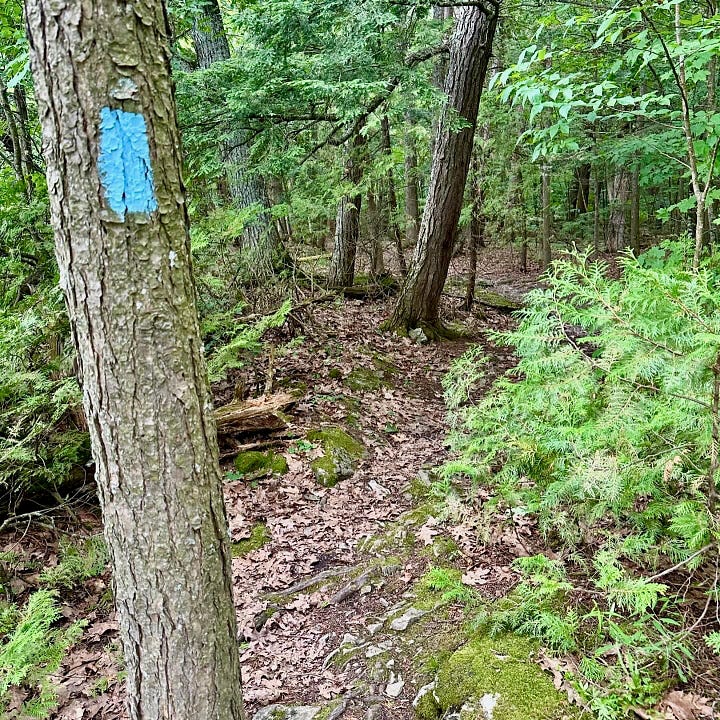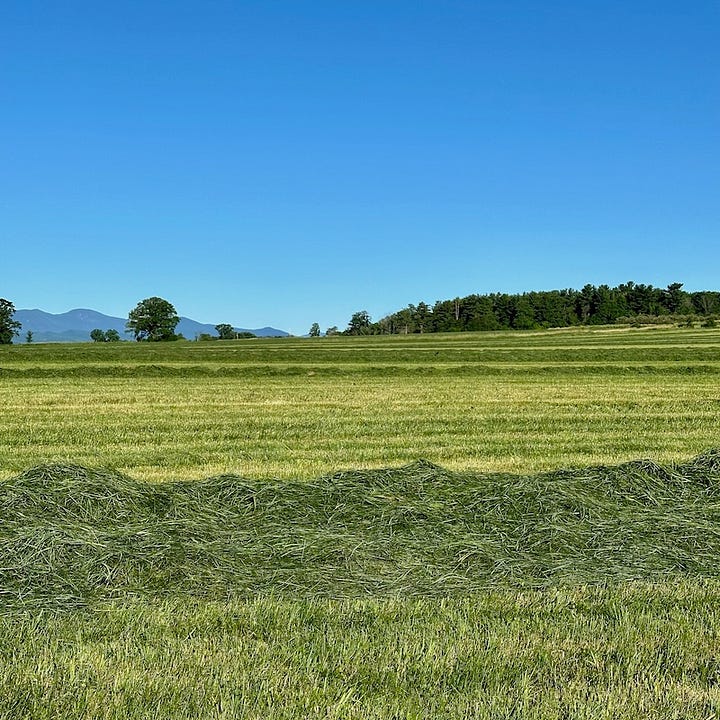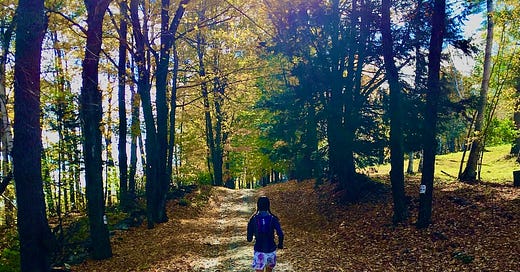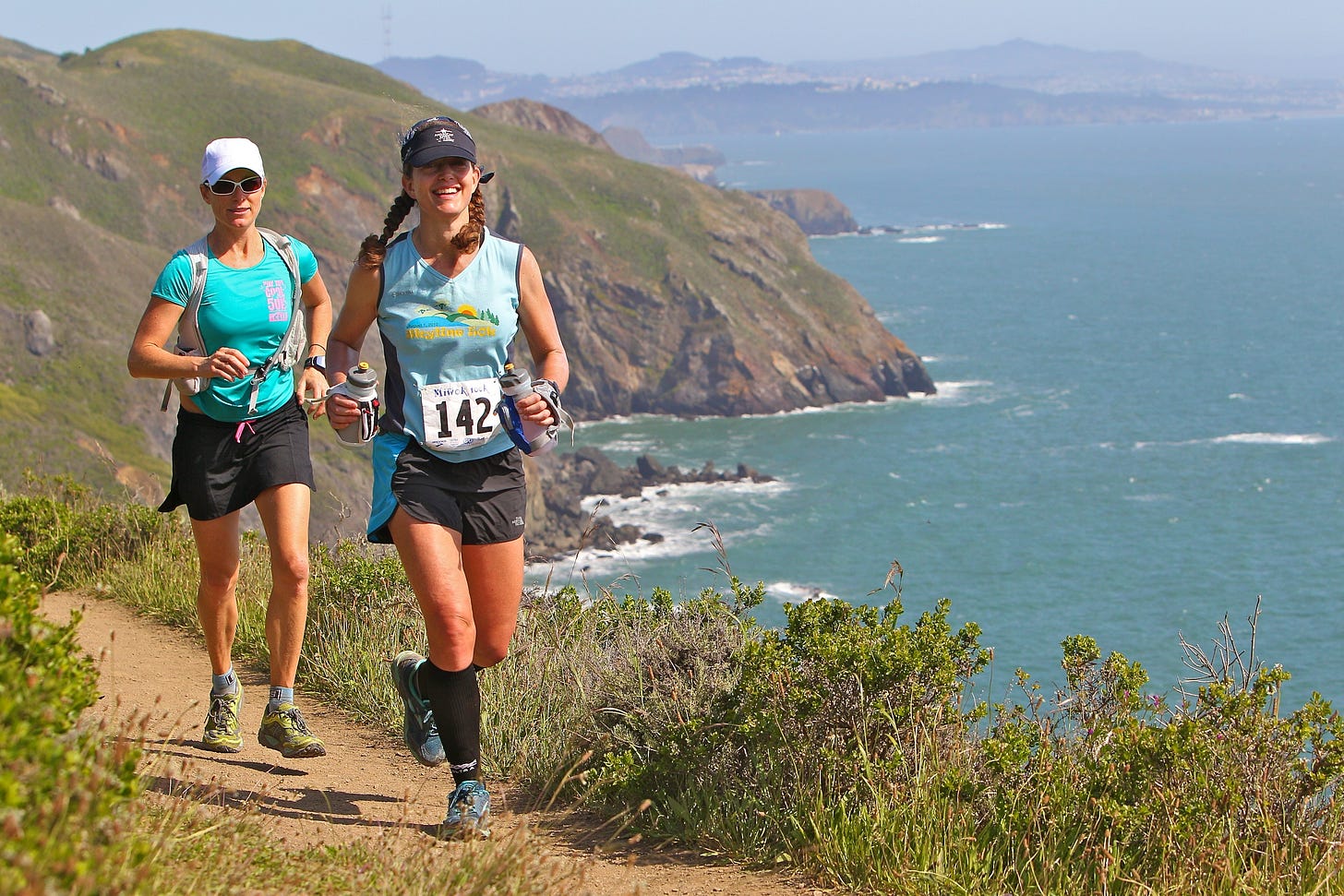Writing this newsletter for nearly three years has enabled me to get to know several of the subscribers, especially those in the paid-subscriber group who participate in our monthly Zoom. I’m pleased to spotlight one of those readers this week who has a compelling running story. Scroll down to the second half for some commentary about Western States’ back of the pack and a personal update.
Running Her First 100 at 62
I love stories about late-bloomers who personify the saying, “It’s never too late to [fill in the blank].” For example, a lifelong family friend found true love in her 60s and got married for the first time last week at 65. She didn’t give up on relationships in spite of heartbreak and disappointment earlier in life.
I especially love examples of people who realize it’s not too late to get healthy and try running. This is one of those stories.
Being in Vermont last week for my friend’s wedding made me think of a subscriber in this group, Ali Lopez, who lives in Vermont and is getting ready for her first 100-miler, the Vermont 100, which takes place in 2.5 weeks, July 19.

Ali took up running at 48 and is 62 now. She lives near Montpelier with her partner of 20 years, Michael, and works as a professional cook and personal chef.
In the Q&A below, she shares how running has been part of her ongoing recovery from anorexia and bulimia earlier in life, and also how she returned to running after healing from a traumatic eye injury that left her with impaired vision.
Ali also writes a Substack that you can and should subscribe to here,
.Me: The VT100 is a little less than three weeks away. How are you feeling about it, and what are your goals?
Ali: Excited and terrified, which I guess is a good thing. I am also keeping my fingers crossed that our weather cooperates and we don't have another natural disaster. Last year, I was supposed to run the Vermont 100, and the race was canceled three days before as a result of catastrophic flooding. It was the right call, but a tough one. My goal is to finish under 30 hours! (That's the cutoff.) I guess a bonus goal would be to actually feel good at the finish!
Did you have a coach or did you follow a training plan?
Both and neither. I looked at a lot of training plans and spoke with friends who have either run the VT 100 or other 100s, and some who are also coaches themselves. They gave me good advice. I also spend a lot of time on my feet at work, so I have learned to count that toward "time on feet" training, since I also know high mileage doesn't work for me, and I do best when not running every day. I made myself a "plan" based on all the info. I also know that I do not like following a plan, but more of a guideline. In other words, if I want to switch up a run or a day, that works for me. Or at least it has in the past; we will see how it works out this time.
In your newsletter, you wrote about a freak accident that severely injured your eye in 2017 and necessitated surgeries. You were doing PT exercises for your shoulder: “I picked up my green stretchy exercise band and put it in the door, as I had been doing for the past six weeks. And then my world changed. … The exercise band slipped out of the door and came charging at me at what felt like 30 mph, like a slingshot to the eye. I hit the floor, grabbed my eye, screamed and curled into a ball. Everything went black…” How impaired is your vision now, seven years since the injury?
I feel incredibly lucky that I have vision out of my left eye. It was terrifying those first few months of seeing blackness when I tried to see out that eye. Now if I cover my right eye, I can see out the left eye; it is just a bit blurry, and there is no peripheral vision, and depth perception is a bit off.
Is your night vision affected, and do you have any concerns about nighttime running during the VT100?
My biggest issue with night vision is glare. As a result of my surgeries, the left pupil is in a fixed position, so it stays dilated. So if light shines toward the eye, it is extremely bright and distracting. Also, that eye tends to get much drier as a result, so I need to use eye drops after a few hours of running or the eye gets very red and uncomfortable. So, yes! I am slightly concerned about night running. I will wear a waist light and a head lamp and have pacers, and carry my eye drops, so I’m hopeful all will go well.
Did you do other sports or work out before becoming a runner at 48?
I tried mountain biking for a few years, and that was fun, but after falling a few times and breaking some things, I decided that maybe my feet were better than the bike! I've always been active in my work but didn't really do sports. Growing up, there were not as many options for girls in sports.
You made a reference in a newsletter post to being a smoker and unhealthy earlier in life; can you elaborate?
I was a smoker for about 15 years and did the usual (for the 1970s) experimenting with drinking and drugs. But I guess by unhealthy, I was speaking to my eating disorder, which started around 14 or 15 as well.
What would you like to share about your ED history? I know that eating disorders and disordered eating can be on a spectrum; I’m curious how severe yours was or is, at what time in your life was it at its worse, and do you feel recovered now or is it something you still treat and manage?
It’s interesting that you ask this, as I am in the process of writing a post related to my eating disorder and the idea of "recovered and in recovery." In my teens, it was pretty severe anorexia. I was hospitalized twice, but in the ’70s, they really had no idea what to do with eating disorders, so I would gain the weight, and nothing else really changed. In my early 20s, it morphed into more bulimia, and then I had a good stretch of feeling "recovered" in my late 20s and 30s. There have been a few relapses over the years, but nothing too severe and more situational. My 40s and 50s were a much smoother ride, and I became more motivated to work on things and look closer at behaviors and thoughts. There was also a lot more being written and spoken about EDs at this time. At this point in my 60s, I feel "recovered," although I can recognize when old triggers are there and how to manage them.
Has your relationship to running helped your eating disorder, and if so, how? Or does it trigger it?
I definitely feel that my running has helped me with my ED. When I was in the worst of my anorexia, exercise was punishment, and now running is my joy. When I first started running longer distances, I had to be careful not to go down the slippery slope of thinking of "deserving food" and "burning off food," but over the years I have realized that food is the fuel that allows my body to do all the things it can do.
A big mindset shift happened when I had my first dexa scan [a bone density scan] in my 50s and was diagnosed with osteoporosis, although as a runner I was always told, "oh, you have nothing to worry about." Turns out I did. All the years when your body is building bone, in the teens through 20s, I was basically starving my bones. So even though I got better with eating in my 30s, most of the damage was done. This diagnosis got me angry and motivated me to do all that I could to preserve what I had and gain more weight.
Do you feel any age-related decline in your early 60s, or do you still have “fresh legs” since you started running at 48?
Ha! I don't know if I ever had "fresh legs"! But yes, I have noticed that I am definitely slower than I was when I started running. These days, I’m not sure I could get that same BQ that I got.
You ran the Boston Marathon in 2017. What is your marathon PR?
For Boston I needed to break 4 hours, and I got a 3:58!
Have you learned or experienced anything that’s different in this prep for your first 100 compared to prior 50Ks/50Ms?
Definitely. This is the first time I used hours-based training more than actual mileage training. For example, on a recent big training weekend, I ran four hours then three hours then two hours. I find especially with the hilly terrain here in Vermont, that makes more sense for me versus having mileage goals. I have also incorporated a lot more hiking or power-walking in my runs. Another big thing that I have been working on is nutrition, as I know that will be key in my success. For 50K and even 50-mile distance, I have been able to get away with not eating or drinking as much, as I have a pretty sensitive tummy, but I know that won't work with 100 miles.
Do you have any recommendations for must-run routes for visitors to Vermont?
Honestly, you can't go wrong running anyplace in Vermont. The amount of dirt roads in beautiful places is amazing. If you are coming from out West, though, beware as Vermont trails are roots and rocks and roots and rocks, so lots of hiking in those trail runs. Any of the mountains that have trails are a good choice. The causeway is a beautiful run as it runs for miles on Lake Champlain. There is not too much flat running here, except for the Burlington bike path, the Stowe bike path, and the Lamoille Valley rail trail, all good for running and biking.


Thank you, Ali, for sharing your story, and I can’t wait to read in your newsletter about how the Vermont 100 goes!
The Courage to Finish at the Back
If you got swept up in coverage of the 100-mile Western States Endurance Run last weekend, as I did, you probably focused on the incredible performances in the top 10, all of which are much faster than they used to be.
I’ve been following the Western States Endurance Run for two decades now, and I recall the drama of the race in 2010, which was captured in the innovative must-see documentary film Unbreakable. That year, Geoff Roes, Anton Krupicka, and a young Kilian Jornet battled for the lead, and Geoff won it in 15:07. The woman’s winner that year, Tracy Garneau, took 19:01. Those times have been totally eclipsed by faster performances in the last handful of years. The all-time top-10 men’s times are now all sub-15 hours, and the all-time top-10 women’s times are now in the 15.5 to low 17-hour range. Nine of the 10 fastest women’s times were run in the last two years; only Ellie Greenwood’s prior course record from 2012 still makes the women’s top 10.
It used to be unthinkable that women could break 16 hours at States, but Courtney running 15:29 opened up a new realm of possibility, akin to breaking the 4-minute-mile barrier.
The top ultrarunners are now running 100-milers more like marathons, sustainably fast and focused from the start, with greater precision of pace and effort and less room for error. It’s exciting to witness all-out efforts finishing in sprints, as we saw in the men’s race last Saturday as Rod Farvard finished just 16 seconds ahead of Hayden Hawks for second and third place, their 14:24 times making them the third and fourth fastest ever at the Western States 100.
But in my mind, this new era of extra-fast finishes with broadcast coverage diminishes the traditionally laid-back aspect of the sport’s culture. We’re so caught up in following the livestream of these incredible performances at the front of the pack, and celebrating when new speed records are set, that we’re normalizing and expecting ultras now to be balls-out speed contests between the top runners more than personal endurance journeys for the vast majority of runners.
I’m here with a simple but perhaps timely reminder that you don’t need to be fast to be successful at ultrarunning. You don’t need to be competitive to matter. It’s still a sport more about steadiness, perseverance, logistical strategy, and mental tenacity as it is about pure fitness and raw speed. The heart of the sport is still in each individual’s personal journey more than in the competition for podium spots.
When I made the shift from road marathoning to ultra-distance trail running in the mid-2000s, everything I read and heard from others about the sport told me to “chill out” and be more tortoise-like. Hike instead of run the uphills to preserve energy for the long haul. Spend extra time eating and drinking at aid stations. Keep your pace at a conversational level and chat with the runners around you, so you stay in a mellow zone of effort (Zone 2, but we weren’t measuring heart rate to be that precise), and enjoy the company of those around you. I still think that’s good advice.
I need to remind myself of this advice, and de-emphasize speed, because I’m feeling extra self-conscious and discouraged about how slow I’m running these days. My body is not operating and recovering like it used to. I’m facing September’s self-supported stage race, the 170-mile Grand to Grand Ultra, with the realization that I’ll be slower than ever due to the combination of my slower speed plus the sand, heat, and weight of my pack, so my pace will average a hiking pace of maybe three miles an hour. I’ll barely run. And I need to mentally make peace with that reality and be a desert tortoise to make it to the finish.
This is hard for me emotionally, because when I ran the Grand to Grand five years ago at age 50 in 2019, I won it—first female and only woman in the top 10 overall. I rocked it. I felt awesome, at the top of my game.
What happened to my body over five years? Menopause, mainly. (Even though I’m on estrogen/progesterone therapy, a recent blood test revealed that my testosterone level went from very low to virtually nonexistent.) Also, knee soreness from patella cartilage degeneration, reduced oxygen-carrying capacity in spite of being altitude-adapted, and a general need for extra recovery. But extra recovery isn’t really an option in a stage race with back-to-back hard efforts (the event’s first five stages are all marathon to 50K in length with an extremely tough 53-miler for stage 3).
So I’m coaching myself: Stop worrying so much about speed and how you compare to others. Just get from Point A to Point B within the time limit, as efficiently as possible, and leave something in the tank for the next day’s effort. Make peace with being in the mid to back of the pack instead of toward the front.
I’m better able to absorb that message thanks to two friends at the back of Western States’ pack who greatly inspire me. They had to courage to go the distance and finish last, even though they’re typically much faster and should have finished well under the cutoff times.
If you watched the livestream of the Golden Hour of Western States (the final hour when back-of-the-packers strive to finish before the 30-hour cutoff), you likely witnessed the nail-biting and heartbreaking finish of Will Barkan, a blind runner who runs with a guide. He missed the cutoff, and thus missed earning a coveted buckle, because he finished 31 seconds over 30 hours. (Click through this Instagram post to watch his finish.)
I know and care about Will. I used to coach him and coached him to finish his first 100-miler, as told here in my mothballed old blog. Will is a talented ultrarunner and has the fitness and smarts to finish well under the 30-hour cutoff. But he faced challenges—not only his very limited vision, caused by an inherited form of juvenile macular degeneration, which makes him prone to trip and fall, but also cramping and knee pain during the day. He must have felt discouraged and slow. But he kept at it instead of dropping. He went the distance.
Eight minutes later—DFL (dead f***ing last)—my old friend Suzy Kisylia came around the track. She is my age, and we used to train together in the Bay Area. She is a really strong runner and usually just slightly faster than me, and I always think of her as my equal in running. There she was on the livestream (in this video, scroll to 8:23:00) painfully jogging the final 100 meters, finishing last place, eight minutes over the cutoff time, with a smile on her face.
I started crying when I saw Suzy even more than when I teared up watching Will finish just past the cutoff. I could feel myself in Suzy’s shoes.
What incredible courage it takes to finish at the back instead of drop out when you know, on a better day when things go right, you would’ve finished hours ahead. Do I have that courage? Would I have kept going like Will, after falling repeatedly and aggravating my troublesome knee? Would I have kept going like Suzy, suffering nausea as she did, even after I did the math in my head and knew I probably wouldn’t make it? Could I smile and feel pride for finishing, even being last?
When (not if) I struggle at the Grand to Grand Ultra and contemplate dropping, and I beat myself up by comparing my performance with my 2019 times there, I will hold onto the images of Will and Suzy finishing, and I’ll keep going.








Great article Sarah, as always! I empathize with Ali, big time! I ran my first ultra at 57, first 100 at 62 (Grindstone, paced by one Sophie Speidel), and just ran my 3rd hundred the 1st of June (Old Diminion, Sophie was my safety runner) at the ripe young age of 64. This was my 45th ultra in the last 8 years, so yay for getting older!
I’m thru-hiking the A.T. next year after I retire, the Lord willing, so won’t be racing as much in ‘25, but plan on a couple of ultras before I start and after I finish my thru-hike. Again- yay for getting older! Keep up the great writing!
Cheers!
Best of luck to Ali! I loved hearing her story. I've always thought of running ultras someday in the far future so it's nice to see that idea isn't farfetched